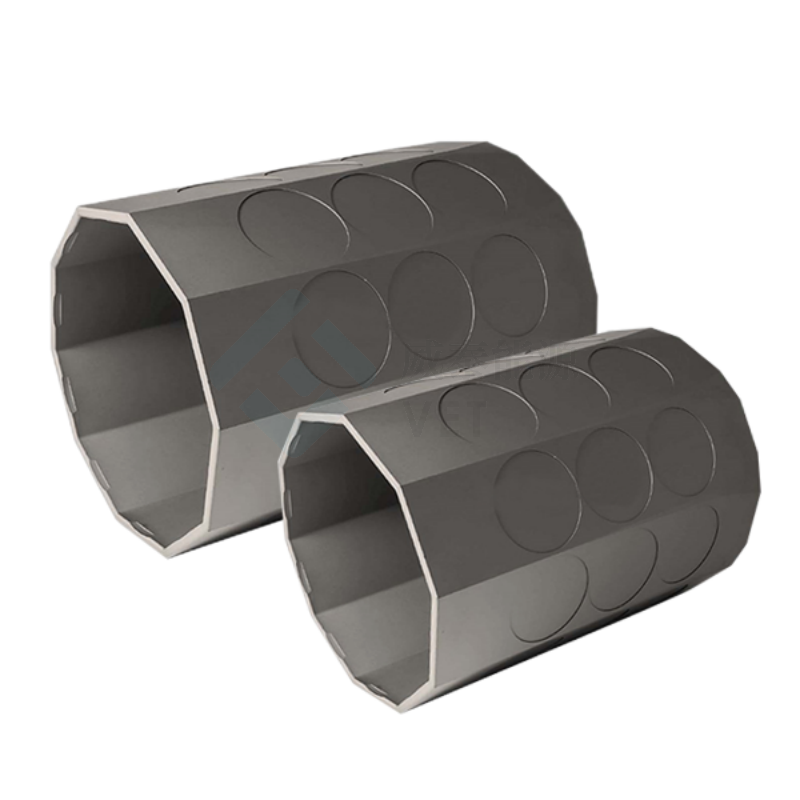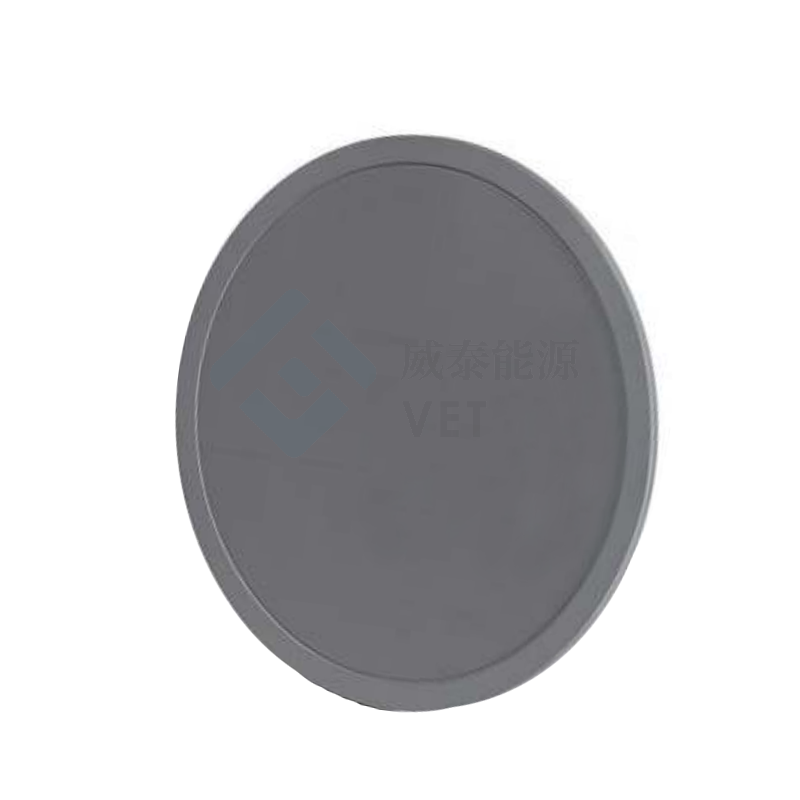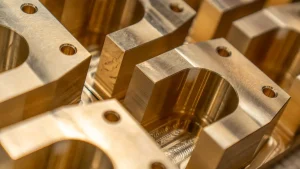CVD SiC coatings play a pivotal role in semiconductor manufacturing by offering exceptional thermal stability and chemical resistance. These CVD coatings ensure high production yields by minimizing contamination risks and extending component lifespans. Selecting the right SiCコーティング product enhances efficiency and reduces maintenance costs. Standout options, such as Ningbo VET Energy Technology Co.’s innovative CVD SiCコーティング solutions, exemplify reliability in this field.

要点
- CVD SiCコーティング help make semiconductors by staying strong in heat and resisting chemicals, which boosts production success.
- Choosing the right CVD SiC coating lowers repair costs and makes important parts last longer, working well in hot processes.
- Top products, like those from Ningbo VET Energy Technology Co., give custom solutions for special needs in making semiconductors.
Overview of CVD SiC Coatings
CVD SiC coatings have become indispensable in semiconductor manufacturing due to their unique physical and chemical properties. These coatings provide solutions to challenges faced in high-temperature and chemically aggressive environments, ensuring precision and reliability in fabrication processes.
Key Properties of CVD SiC Coatings
CVD SiC coatings exhibit several critical properties that make them ideal for semiconductor applications:
- Exceptional thermal stability ensures consistent performance during high-temperature processes.
- High chemical resistance protects equipment from corrosive gases and chemicals.
- A smooth surface finish minimizes contamination risks, maintaining the purity of semiconductor wafers.
- Structural integrity is retained at elevated temperatures, unlike metals.
- Acts as a robust barrier against corrosive substances, preventing material degradation.
These properties enable CVD SiC coatings to withstand the demanding conditions of semiconductor manufacturing, ensuring durability and reliability.
Benefits for Semiconductor Applications
The use of CVD SiC coatings in semiconductor manufacturing offers numerous advantages:
- Exceptional thermal stability ensures consistent performance during high-temperature processes.
- Chemical resistance protects equipment from corrosive gases and chemicals.
- An ultra-smooth surface finish enhances wafer quality and reduces contamination risks.
- Extends the lifespan of critical components, minimizing downtime and maintenance costs.
- Provides a stable platform for uniform heat distribution, reducing thermal stress on wafers.
- Prevents particle generation and chemical reactions, ensuring a clean surface for deposition.
These benefits make CVD SiC coatings a preferred choice for achieving high production yields and maintaining stringent purity standards.
Common Challenges Addressed by CVD SiC Coatings
Semiconductor manufacturing involves extreme conditions that demand precision and resilience. CVD SiC coatings address these challenges effectively. Their thermal stability ensures reliable performance during high-temperature processes like chemical vapor deposition and etching. Their chemical resistance safeguards equipment from corrosive substances, while the ultra-smooth surface finish reduces contamination risks. These features collectively enhance the quality of semiconductor wafers and improve overall manufacturing efficiency.
Key Criteria for Evaluating CVD SiC Coatings
Thermal Resistance and Stability
Thermal resistance is a critical factor in evaluating CVD SiC coatings. These coatings maintain their structural integrity even at temperatures as high as 1600°C. Unlike metals, which weaken under extreme heat, CVD SiC coatings provide consistent performance during high-temperature processes such as chemical vapor deposition and etching. This stability ensures reliable operation and minimizes the risk of thermal stress on semiconductor wafers. Furthermore, their ability to distribute heat uniformly enhances process efficiency and reduces defects in wafer production.
Chemical Durability and Corrosion Resistance
CVD SiC coatings excel in chemically aggressive environments. Their dense and uniform grain structure acts as a robust barrier against corrosive substances, preventing chemical penetration. This feature is particularly valuable in semiconductor manufacturing, where exposure to harsh chemicals is frequent. These coatings also resist oxidation and other chemical reactions that could degrade materials, ensuring components remain functional and efficient. Their chemical durability significantly extends the lifespan of equipment, reducing maintenance needs and operational downtime.
Application-Specific Suitability
The suitability of CVD SiC coatings depends on several factors. Deposition parameters, such as temperature, pressure, and gas flow rate, influence the coating’s microstructure and properties. Substrate material compatibility also plays a vital role, as it affects adhesion and coating performance. Post-deposition treatments, including annealing and polishing, further refine the coating’s characteristics. For example, in oxide etch chambers, coatings with ultra-smooth surfaces are essential to minimize contamination risks and maintain wafer purity.
Cost-Effectiveness and Longevity
While the initial investment in CVD SiC coatings may be higher than traditional materials like graphite or quartz, their long-term benefits outweigh the costs. These coatings offer exceptional thermal stability and chemical resistance, leading to improved yields and reduced maintenance expenses. For instance, CVD SiC-coated susceptors used in high-temperature processes demonstrate superior durability, minimizing the need for frequent replacements. This cost-effectiveness makes them a preferred choice for semiconductor manufacturers aiming to optimize operational efficiency.
Top CVD SiC Coating Products for Semiconductor Applications

Ningbo VET Energy Technology Co.Ltd – SiC Coating for RTP Components
Ningbo VET Energy Technology Co. offers a specialized SiCコーティング designed for rapid thermal processing (RTP) components. This product enhances semiconductor manufacturing by delivering several key benefits:
- Improves durability, ensuring long-lasting performance in demanding environments.
- Provides exceptional thermal stability, critical for maintaining precision during high-temperature processes.
- Offers contamination resistance, reducing the risk of defects in semiconductor wafers.
SiC-coated graphite substrates are a standout feature of this product. These substrates serve as susceptors, holding and heating semiconductor wafers during thermal processing. Their thermal shock resistance and excellent thermal conductivity make them indispensable for RTP applications. This coating ensures consistent results, even under extreme conditions, making it a reliable choice for semiconductor manufacturers.
Ningbo VET Energy Technology Co. – SiC Coating for Oxide Etch Chambers
For oxide etch chambers, Ningbo VET Energy Technology Co. provides a tailored SiC coating solution. This product addresses the unique challenges of etching processes by offering:
- Superior chemical resistance, protecting components from corrosive etching gases.
- An ultra-smooth surface finish, minimizing particle generation and contamination risks.
- Enhanced durability, extending the lifespan of chamber components.
This coating ensures optimal performance in oxide etch chambers, where precision and cleanliness are paramount. Its ability to withstand harsh chemical environments while maintaining a pristine surface makes it a preferred choice for semiconductor fabrication facilities.
SUPERSiC® Silicon Carbide Coating
SUPERSiC® Silicon Carbide Coating combines advanced material properties to meet the rigorous demands of semiconductor manufacturing. Key features include:
- Thermal stability, withstanding rapid temperature changes without compromising structural integrity.
- Mechanical strength, blending graphite’s resilience with SiC’s hardness for exceptional durability.
- Chemical resistance, protecting against oxidation and corrosion in harsh environments.
This coating excels in high-heat processes, remaining stable at temperatures up to 1600°C. Its passivated SiO2 layer enhances chemical stability, resisting acids and alkalis. With hardness approaching that of diamond, SUPERSiC® offers unmatched wear resistance, ensuring long-term reliability in semiconductor applications.
Competitor Product – Advanced SiC Coating for Photovoltaic Applications
A competitor product focuses on photovoltaic applications, offering advanced SiC coating technology. This product provides:
- High thermal resistance, ensuring stability during solar cell manufacturing.
- Chemical durability, protecting components from corrosive substances.
- Cost-effectiveness, making it an attractive option for large-scale production.
While tailored for photovoltaic applications, this coating demonstrates versatility, making it suitable for certain semiconductor processes. Its balance of performance and affordability positions it as a competitive option in the market.
Comparative Analysis of Top Products
Feature-Performance Table
A detailed comparison of performance metrics highlights the strengths of each product. The table below outlines key metrics for CVD SiC coatings and alternative APS-SiC coatings:
| Performance Metric | CVD-SiC | APS-SiC |
|---|---|---|
| Hardness (GPa) | 31.0 | 9.7 |
| Wear Volume (mm³) | 1.403 × 10⁻³ to 4.37 × 10⁻³ | 0.072 to 0.399 |
| Friction Coefficient | Stabilized around 0.2 | Fluctuated significantly |
CVD SiCコーティング demonstrate superior hardness and wear resistance, making them ideal for high-precision semiconductor applications. Their stable friction coefficient ensures consistent performance, even under demanding conditions.
Key Differences and Similarities
Despite their unique compositions, top CVD SiC coating products share several common features. All products exhibit exceptional thermal stability, enabling reliable operation in high-temperature environments. Their high corrosion resistance ensures durability in chemically aggressive conditions, reducing maintenance costs over time.
However, differences arise in their specific applications and material compositions. For instance, NTST Silicon Carbide Coatings offer excellent corrosion resistance but face challenges in fabrication. In contrast, CVD SiC Coated Susceptors excel in high-temperature resistance but may involve higher production costs. These distinctions guide manufacturers in selecting the most suitable product for their needs.
Strengths and Weaknesses of Each Product
The table below summarizes the strengths and weaknesses of leading CVD SiC coating products:
| プロダクト | 強み | ウェイクネス |
|---|---|---|
| SiC3 High Purity Coating | High density, excellent coverage, adjustable surface roughness | Limited part size, limited customization |
| Nanomakers High Purity Coating | Exceptional uniformity, versatile application methods | Higher cost, limited availability |
| Washington Mills Coating | Enhanced oxidation resistance, low cost | Potential blister formation, limited durability |
| Advanced Ceramic Coatings | High durability, hydrophobic properties, UV resistance | N/A |
Each product offers unique advantages tailored to specific applications. For example, SiC3 coatings provide high purity and density, making them suitable for semiconductor manufacturing. Meanwhile, Nanomakers coatings excel in uniformity, ensuring consistent results across various processes.
Decision-Making Guide for Choosing the Best Product
Matching Coating Features to Application Needs
Selecting the right cvd sic coating depends on aligning its features with the specific demands of the application. Semiconductor manufacturing processes often involve extreme conditions, requiring coatings that excel in durability, thermal resistance, and corrosion protection. For instance, rapid thermal processing (RTP) components benefit from coatings with excellent thermal shock resistance and heat distribution. Similarly, oxide etch chambers demand ultra-smooth surfaces to minimize contamination and ensure wafer purity.
Applications such as LED chip fabrication or silicon epitaxy require coatings that maintain structural integrity under high temperatures and resist wear caused by plasma erosion. The table below highlights common application areas and their coating requirements:
| 応用分野 | 説明 |
|---|---|
| LED Chip Fabrication | Used in the production of LED chips. |
| Polysilicon Production | Essential for creating polysilicon materials. |
| 半導体結晶成長 | Supports the growth of semiconductor crystals. |
| Silicon and SiC Epitaxy | Facilitates the epitaxial growth of silicon and silicon carbide. |
| Thermal Oxidation and Diffusion | Important for thermal oxidation and diffusion processes. |
Matching these features ensures optimal performance and longevity in semiconductor manufacturing.
Budget Considerations
Budget plays a crucial role in decision-making. While CVD SiC coatings may involve higher initial costs compared to traditional materials, their long-term benefits often justify the investment. These coatings reduce maintenance expenses by extending component lifespans and minimizing downtime. For manufacturers with limited budgets, prioritizing application-specific needs can help balance cost and performance. For example, RTP components may require premium coatings, while less demanding processes could utilize cost-effective alternatives.
CVD SiC coatings play a vital role in semiconductor manufacturing by enhancing the durability of susceptors, ensuring structural integrity during high-temperature operations, and reducing contamination risks. Their exceptional thermal stability guarantees consistent wafer quality, while their chemical resistance protects equipment from corrosive substances. These features collectively improve production efficiency and reduce maintenance costs.
Standout products, such as Ningbo VET Energy Technology Co.’s SiC coatings for RTP components and oxide etch chambers, exemplify reliability and innovation. Their tailored solutions address specific challenges in semiconductor processes, ensuring optimal performance and extended component lifespans.
To select the best CVD SiC coating, manufacturers should prioritize material quality for thermal conductivity and chemical stability. Compatibility with equipment, such as MOCVD systems, ensures efficient heat transfer. Customization options and supplier reputation should also guide decisions. Sample testing can validate performance before large-scale adoption, balancing cost and operational efficiency.
製品の詳細については、下記までお問い合わせください。 steven@china-vet.com またはウェブサイト: www.vet-china.com.






